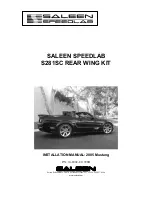
Attachments with high centre of mass
At vehicles with high attachments or with a raised overall centre of mass, the driving conditions are limited.
Stabilizer bars are used to prevent excessive heeling of the vehicles.
The following
table
shows which centre-of-mass height is permitted for vehicles with standard equipment. These heights
must
not be exceeded
. In addition, the table shows for which vehicle variants
stabilizer bars or reinforced stabilizer
bars are recommended
.
The maximum permitted centre-of-mass heights indicated in the table
may under no circumstances be exceeded
.
Type
PR-
No.
Stabilizers
Centre of
mass of the
chassis
Dimensions
mm
X
Overall
centre of
mass of the
vehicle
Dimensions
mm
Y
Max. permitted
centre-of-mass height of
attachment and net load
above lane in mm
Front
axle
Rear
axle
Dimension
Z
Standard
equipment
Stabilizers
OAB
&
OBB
Box-type/station OJ1
OJ2
S
-
757
858
1140
Flatbed/double
cab
OJ2
S
-
688
850
1180
Chassis
OJ2
S
-
654
850
1160
Box-type/station OJ3
S
-
757
850
1185
Flatbed/double
cab
OJ3
S
-
688
850
1120
Chassis
OJ3
S
-
654
850
1120
Box-type/station OJ2
A
B
757
980
1480
Flatbed/double
cab
OJ2
A
B
688
980
1510
Chassis
OJ2
A
B
654
980
1460
Flatbed/double
cab
OJ3
A
B
757
980
1405
Pritsche/Doka
OJ3
A
B
688
980
1430
Chassis
OJ3
OJ4
A
B
654
980
1390
s
- 23 mm stabilizer bar, front, available as standard
A
- 27 mm stabilizer bar, front, available as extra equipment (OAB)
B
- 26 mm stabilizer bar, rear, available as extra equipment (OBB)
Note
: The PR-No. OJ2 and OJ3 include also the syncro variants.
Centre-of-mass height specifications according to directive 71/320 EEC
Since 01/01/1991, all utility vehicles must
comply with the requirements of the "
EC Directive on Brake Systems, 71/320/EEC
". The adoption of this EC directive
into German traffic registration regulations
(StVZO)
results in a situation in which these technical directives must also be
fulfilled at single acceptances (trial runs).
59







































